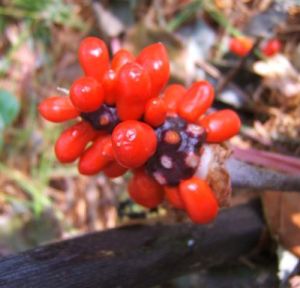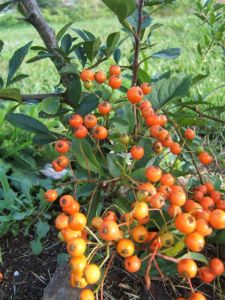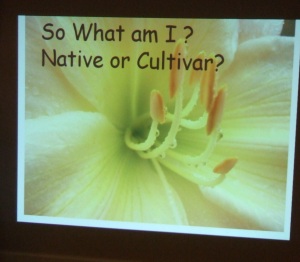Native vs. Cultivar: a Plant Quiz

When looking at photographs of plants, the size or even the angle at which the subject was photographed can deceive the viewer. At the November meeting of Chester Garden Club, members were presented with a series of photographs and then challenged to identify the native plants and distinguish them from common cultivars. The interactive presentation was handled by Brenda Hiltz, a Master Gardener, who provided all participants with paper and pencil and then showed them a series of over 40 slides of plants, some in flower and some with fruit. Participants were asked to write down the name of each plant shown and to specify whether it was a native species or a cultivar. On completion of that task, to help everyone mark their scores, Brenda showed the crowd the same photos in the same sequence but with the botanical and common name of each plant added to the image. As each name was revealed, gasps of surprise (or delight, if a plant had been correctly identified) could be heard throughout the room. After tallying their scores, most members were quite chagrined to realize how many plants they had misidentified but all agreed that, in future, they would be more aware of the native plants that add a significant decorative element to the natural landscape. A small selection of Brenda’s floral mystery photos and relevant information is included in this post.

As an inveterate hiker and canoeist, Brenda has been photographing native plants throughout the province for many years. The trout lily [Erythronium americanum] is a herbaceous flowering plant that blooms in early spring. The plants grow in colonies, some of which have survived as long as 300 years.

Another native species is the Meadow Anemone above, commonly known as Crowfoot. It blooms from late spring to summer and its seeds are borne in achenes (which are small, dry, hard one-seeded fruit). It was used by North American indigenous peoples as an astringent and as a styptic for wounds, sores, nosebleeds and as an eye-wash.


This herbaceous perennial is native to eastern North America and is found in moist woodlands. In contrast to the medicinal properties of Crowfoot, Jack-in-the-pulpit contains oxalic acid, which is poisonous if ingested. Even if only handling the seeds and pulp, it is advisable to wear gloves. The plant’s flowers are contained in a spadix, which is covered by a hood, giving the plant its distinctive appearance.

Although the fruit of the Daphne mezereum is poisonous to humans, many birds eat them and then spread their seeds via their droppings. The scented flowers of this Eurasian shrub are produced in early spring on bare stems before the leaves appear.


Pyracantha angustifolia, a species of shrub in the rose family, commonly known as Firethorne, is native to China but has been introduced to North America as an ornamental plant that also serves as a prickly hedge because of its sharp spines. The small orange or red pomes (fleshy fruit) are astringent and bitter-tasting to humans but a good food source for birds.
Another imported plant that is widely used in North American gardens is the Gerbera daisy, or African daisy. This tender perennial is attractive to bees, butterflies and birds but resistant to deer – an important feature for many Chester gardeners! This genus from the sunflower family, with about 30 species in the wild, is found in South America and tropical Asia as well as Africa. It has thousands of cultivars, which come in many colours and sizes, and it is a popular cut flower (being the fifth most-used cut flower in the world, after the rose, carnation, chrysanthemum and tulip).


